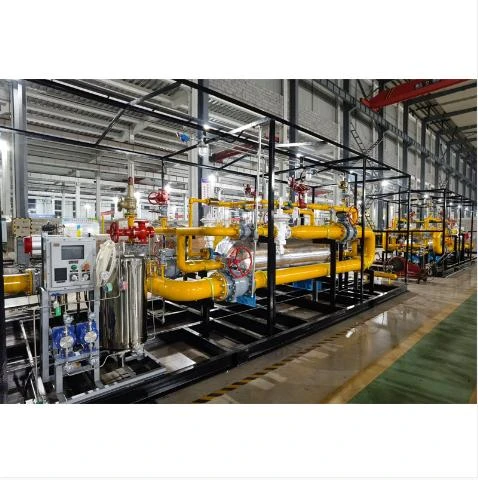
Nov . 09, 2024 22:21
Back to list
Natural Gas Distribution Facility Operations and Management Strategies
The Importance of Natural Gas Distribution Stations
Natural gas has become a cornerstone of energy consumption in modern society. It serves as a reliable and cleaner alternative to other fossil fuels, reducing harmful emissions and contributing to a more sustainable energy future. As the demand for natural gas continues to grow, natural gas distribution stations play a crucial role in ensuring the efficient delivery and distribution of this vital resource.
A natural gas distribution station is a facility that receives high-pressure natural gas from transmission pipelines and reduces its pressure for safe delivery through distribution lines to homes, businesses, and industries. These stations are strategically placed in various locations to create a comprehensive distribution network that can serve urban and rural areas alike.
One of the primary functions of a natural gas distribution station is pressure regulation. High-pressure natural gas arrives from transmission lines, which can operate at pressures around 1,000 psi or more. However, for safe use in residential and commercial applications, the gas must be reduced to a lower pressure—typically between 5 to 60 psi. Distribution stations utilize pressure regulators and control systems to ensure that gas is evenly distributed and that the supply pressure remains consistent and safe for consumers.
In addition to pressure regulation, these stations are equipped with various safety features, including emergency shut-off valves, odorization systems, and monitoring technology. Natural gas is odorless, so a harmless chemical called mercaptan is added to the gas to give it a distinct smell, which helps in detecting leaks. Continuous monitoring of gas quality and pressure ensures that any anomalies can be addressed promptly, minimizing the risk of accidents and enhancing the safety of the distribution network.
natural gas distribution station

Another vital aspect of natural gas distribution stations is their role in managing supply and demand. Demand for natural gas can fluctuate based on time of year, daily consumption patterns, and other socioeconomic factors. Distribution stations help to buffer these variations by storing gas temporarily and managing the flow based on real-time data. This responsiveness is particularly important in peak usage times, such as during extreme weather conditions, when demand for heating, cooking, and electricity generation surges.
Furthermore, natural gas distribution stations are becoming increasingly integrated with renewable energy sources. As countries strive to transition to cleaner energy, combining natural gas with renewables like solar and wind has proven beneficial. Natural gas can serve as a backup power source when renewable generation is insufficient, ensuring that supply remains stable and reliable while reducing overall carbon emissions.
The growing importance of environmental sustainability is fostering innovations and improvements within the natural gas distribution infrastructure. Many distribution stations are adopting advanced technologies such as smart meters and automated monitoring systems. These technologies facilitate real-time data collection, allowing for enhanced management of the distribution system and more precise adjustments to meet consumer demands.
As the global energy landscape evolves, natural gas distribution stations must adapt to new challenges and opportunities. Regulatory frameworks are also evolving to encourage environmentally friendly practices, which may involve retrofitting older stations or constructing new ones with improved designs and technologies focused on sustainability.
In conclusion, natural gas distribution stations are vital components in the energy supply chain, ensuring that natural gas reaches consumers safely and efficiently. Their role in pressure regulation, safety management, supply and demand balancing, and integration with renewable energy highlights their importance in a sustainable energy future. As society increasingly embraces natural gas as a cleaner energy alternative, these distribution stations will remain at the forefront of delivering reliable energy to millions of users, marking a crucial step in the ongoing transition toward a more sustainable energy landscape.
Latest news
-
Safety Valve Spring-Loaded Design Overpressure ProtectionNewsJul.25,2025
-
Precision Voltage Regulator AC5 Accuracy Grade PerformanceNewsJul.25,2025
-
Natural Gas Pressure Regulating Skid Industrial Pipeline ApplicationsNewsJul.25,2025
-
Natural Gas Filter Stainless Steel Mesh Element DesignNewsJul.25,2025
-
Gas Pressure Regulator Valve Direct-Acting Spring-Loaded DesignNewsJul.25,2025
-
Decompression Equipment Multi-Stage Heat Exchange System DesignNewsJul.25,2025

